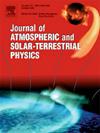A model to estimate energy deposition within the geomagnetosphere using Dst as a proxy for the Akasofu ϵ parameter
IF 1.8
4区 地球科学
Q3 GEOCHEMISTRY & GEOPHYSICS
Journal of Atmospheric and Solar-Terrestrial Physics
Pub Date : 2025-02-28
DOI:10.1016/j.jastp.2025.106480
引用次数: 0
Abstract
This study compares the energy deposited into the geomagnetosphere by 14 co-rotating interaction regions (CIRs) and 14 interplanetary coronal mass ejections (ICMEs), selected from solar cycle 23, and covering a broad range of activity. The energy () is estimated using the Akasofu empirical coupling function and it was found that, on average, the ICMEs deposit about 15 times the energy contributed by the CIRs. The energy correlates very significantly with the peak (most negative) of the hourly geomagnetic index observed during each event (first order fit, = -0.94; second order fit, = -0.97). Two modifications to the Akasofu relation proposed by de Lucas et al. are then incorporated into the energy calculations: the first replaces the radius of the effective area for the dayside magnetopause with a value which is a function of the solar wind ram pressure, and the second takes into account the dynamic pressure of the solar wind itself. As a result, strengthens for the first order fit to -0.96, but weakens slightly for the second to -0.96, though all these correlations are highly significant. An empirical model is proposed of the form , for which regression equations, correlation coefficients, standard errors and 1 uncertainties are provided for both first and second order fits. The model provides an estimate of the energy deposited into the magnetosphere by solar particle events, using ground-based measurements, without recourse to in-situ measurements of the solar wind which are prone to data gaps during very energetic events.
一个利用Dst作为Akasofu ε参数的代理来估计地磁层内能量沉积的模型
本研究比较了从太阳活动周期23中选取的14个共旋转相互作用区(CIRs)和14个行星际日冕物质抛射(ICMEs)沉积到地磁层的能量,涵盖了广泛的活动范围。利用Akasofu经验耦合函数估计了能量(E),发现平均而言,ICMEs沉积的能量约为CIRs贡献的15倍。能量与每次事件中观测到的每小时Dst地磁指数的峰值(最负)非常显著相关(一阶拟合,ρ = -0.94;二阶拟合,ρ = -0.97)。然后将de Lucas等人对Akasofu关系提出的两个修正纳入能量计算中:第一个用太阳风冲击压的函数值代替日面磁层顶有效面积的半径,第二个考虑太阳风本身的动压。结果,ρ在一阶拟合时增强至-0.96,但在二阶拟合时略有减弱至-0.96,尽管所有这些相关性都非常显著。提出了E=f(Dst)的经验模型,给出了一阶和二阶拟合的回归方程、相关系数、标准误差和1σ不确定性。该模型提供了由太阳粒子事件沉积到磁层的能量的估计,使用地面测量,而不依赖于太阳风的现场测量,因为在高能事件期间容易出现数据缺口。
本文章由计算机程序翻译,如有差异,请以英文原文为准。
求助全文
约1分钟内获得全文
求助全文
来源期刊

Journal of Atmospheric and Solar-Terrestrial Physics
地学-地球化学与地球物理
CiteScore
4.10
自引率
5.30%
发文量
95
审稿时长
6 months
期刊介绍:
The Journal of Atmospheric and Solar-Terrestrial Physics (JASTP) is an international journal concerned with the inter-disciplinary science of the Earth''s atmospheric and space environment, especially the highly varied and highly variable physical phenomena that occur in this natural laboratory and the processes that couple them.
The journal covers the physical processes operating in the troposphere, stratosphere, mesosphere, thermosphere, ionosphere, magnetosphere, the Sun, interplanetary medium, and heliosphere. Phenomena occurring in other "spheres", solar influences on climate, and supporting laboratory measurements are also considered. The journal deals especially with the coupling between the different regions.
Solar flares, coronal mass ejections, and other energetic events on the Sun create interesting and important perturbations in the near-Earth space environment. The physics of such "space weather" is central to the Journal of Atmospheric and Solar-Terrestrial Physics and the journal welcomes papers that lead in the direction of a predictive understanding of the coupled system. Regarding the upper atmosphere, the subjects of aeronomy, geomagnetism and geoelectricity, auroral phenomena, radio wave propagation, and plasma instabilities, are examples within the broad field of solar-terrestrial physics which emphasise the energy exchange between the solar wind, the magnetospheric and ionospheric plasmas, and the neutral gas. In the lower atmosphere, topics covered range from mesoscale to global scale dynamics, to atmospheric electricity, lightning and its effects, and to anthropogenic changes.
 求助内容:
求助内容: 应助结果提醒方式:
应助结果提醒方式:


